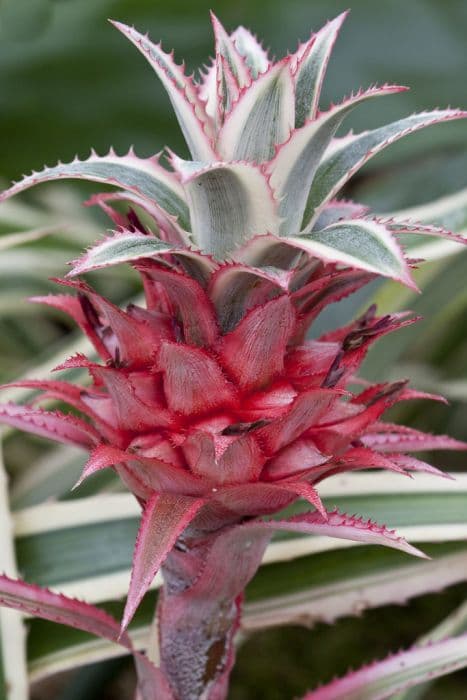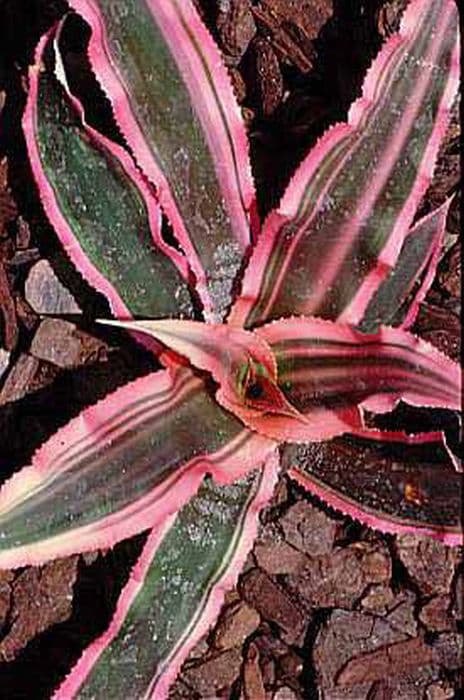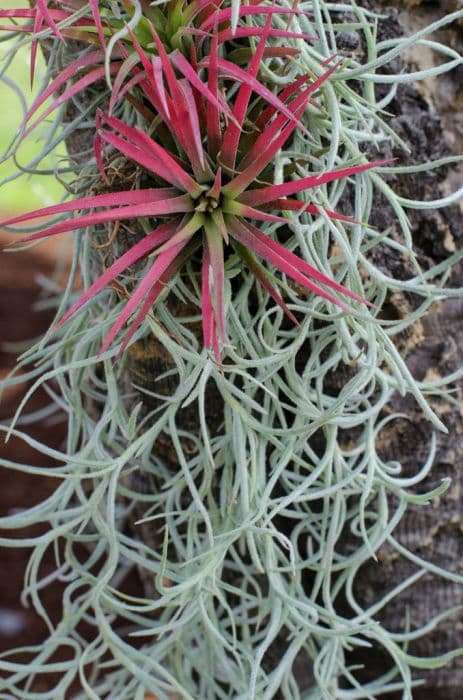Blue Tango Aechmea Aechmea 'Del Mar'

ABOUT
The Aechmea 'Del Mar' is an ornamental bromeliad with a striking rosette of broad, leathery leaves that have a glossy green appearance. The leaves often feature beautifully patterned spines on the edges, adding an element of texture to the plant. Throughout its growth, this bromeliad forms a central cup from the leaf rosette, which typically collects water. The most captivating aspect of the Aechmea 'Del Mar' is its flower spike. The bloom emerges from the center of the plant, showcasing vivid colors that can range from deep purple to pink and blue tones. The contrasting colors between the foliage and the inflorescence make this plant a vibrant and attractive addition to any space. The bracts surrounding the flower spike add further depth to the display with their rich coloration and can maintain their appeal for an extended period before fading. Overall, Aechmea 'Del Mar's lush, tropical look and stunning flower make it a popular choice among plant enthusiasts.
About this plant
 Names
NamesSynonyms
Del Mar Bromeliad
Common names
Aechmea 'Del Mar'.
 Toxicity
ToxicityTo humans
Aechmea 'Del Mar', commonly known as bromeliad, is not considered toxic to humans. There are no known toxic effects from ingesting parts of this plant, and it is generally regarded as safe for typical household or decorative use.
To pets
Bromeliad, the common name for Aechmea 'Del Mar', is also non-toxic to pets. It does not pose a risk of poisoning if pets were to ingest any part of the plant, and there are no specific symptoms of poisoning associated with this plant for animals such as cats and dogs.
 Characteristics
CharacteristicsLife cycle
Perennials
Foliage type
Evergreen
Color of leaves
Variegated
Height
1-2 feet (30-60 cm)
Spread
1-2 feet (30-60 cm)
Plant type
Bromeliad
Hardiness zones
10
Native area
Brazil
Benefits
 General Benefits
General Benefits- Easy Maintenance: Aechmea 'Del Mar' is known for being low maintenance, making it convenient for busy individuals or those new to caring for plants.
- Long-Lasting Blooms: This plant offers long-lasting flowers that can add color and interest to indoor spaces for an extended period.
- Drought Tolerance: It has the ability to withstand periods without water, which is beneficial for those who might forget to water their plants regularly.
- Enhanced Aesthetics: Aechmea 'Del Mar' can enhance the aesthetics of a space with its striking foliage and vibrant bract that offers a tropical feel.
- Compact Size: With its compact growth habit, it is suitable for small spaces such as apartments or offices.
 Medical Properties
Medical PropertiesThis plant is not used for medical purposes.
 Air-purifying Qualities
Air-purifying QualitiesThis plant is not specifically known for air purifying qualities.
 Other Uses
Other Uses- Aechmea 'Del Mar' can be used in terrariums, where its compact size and colorful foliage can create a striking visual impact and mimic tropical environments.
- This bromeliad variety serves as a living vase; you can place water within its central cup to display cut flowers for short-term decorative appeal.
- It could be a novel educational tool in biology classes to demonstrate the concept of epiphytism, where students can observe how Aechmea 'Del Mar' may naturally grow on other plants without being parasitic.
- Aechmea 'Del Mar' might serve as an addition to a green roof planting scheme, where its tolerance for drought and ability to store water can be advantageous for reducing urban heat islands.
- The bright colors of Aechmea 'Del Mar' can be used in color therapy or chromotherapy sessions, leveraging the plant's vibrant hue to influence emotions and mood in holistic practices.
- As a component in living walls or vertical gardens, Aechmea 'Del Mar' adds architectural interest and a pop of color in urban environments or small indoor spaces.
- With its unique appearance, Aechmea 'Del Mar' can be used in artistic installations and set design, lending an exotic or alien aesthetic to creative projects.
- Aechmea 'Del Mar' plants can be given as eco-friendly trophies or awards at events, symbolizing growth and sustainability.
- When used in feng shui, Aechmea 'Del Mar' is said to enhance wealth and abundance, especially when placed in the southeast area of a space.
- In culinary presentations, chefs may incorporate Aechmea 'Del Mar' as an exotic and aesthetic, but non-edible, garnish to tropical or botanically inspired dishes.
Interesting Facts
 Feng Shui
Feng ShuiThe Aechmea, or more commonly known as the Bromeliad 'Del Mar', can be used in Feng Shui to bring vibrant energy and enhance the wood element within a space, promoting growth and vitality. It can be placed in the wealth corner of a room, or the southeast, to potentially attract abundance and prosperity.
 Zodiac Sign Compitability
Zodiac Sign CompitabilityThe Bromeliad 'Del Mar' is not used in astrology practice.
 Plant Symbolism
Plant Symbolism- Resilience: Aechmea 'Del Mar', commonly known as Bromeliad 'Del Mar', often symbolizes resilience due to its hardy nature and ability to withstand varying conditions in its environment.
- Protection: The rosette shape of the Bromeliad 'Del Mar' resembles a shield, leading to its association with protection and defense.
- Uniqueness: Its striking appearance and unique floral structure can represent individuality and the celebration of being different.
- Hospitality: Bromeliads, in general, are a symbol of hospitality, which can be attributed to the welcoming appearance of the bromeliad's bright and inviting inflorescence.
- Adaptability: Given the Bromeliad 'Del Mar's ability to adapt to various light conditions and environments, it is often linked to adaptability and versatility in life.
 Water
WaterThe Aechmea 'Del Mar', commonly known as Bromeliad 'Del Mar', should be watered by filling the central cup of the plant, also ensuring the soil is evenly moist but never soggy. It's recommended to fill the cup with approximately 6 to 8 ounces of water every week, and adjust the amount according to the humidity and temperature conditions. Avoid letting the water sit stagnant in the cup for too long, by emptying and refilling it every few weeks to prevent bacterial growth. During drier conditions or in heated homes, the surrounding soil may need additional water, but always check to ensure the soil is partially dried out before watering again.
 Light
LightBromeliad 'Del Mar' thrives best in bright, indirect sunlight. It should be placed near an east or south-facing window where it can receive plenty of light without being directly exposed to strong afternoon sun. Avoid placing it in full shade or in areas with very dim lighting to ensure healthy growth and vibrant foliage.
 Temperature
TemperatureBromeliad 'Del Mar' prefers warm temperatures typically ranging from 60 to 80 degrees Fahrenheit. It can tolerate a minimum temperature of 40 degrees Fahrenheit but should never be exposed to freezing conditions. The ideal temperature range is centrally around 70 degrees Fahrenheit, ensuring the plant stays comfortable and can avoid cold damage.
 Pruning
PruningBromeliad 'Del Mar' requires minimal pruning. Only remove dead or damaged leaves as necessary to maintain the plant's appearance and health. The best time to prune is in the spring or early summer before new growth starts. The frequency of pruning depends on the individual plant's condition but typically isn't needed more than a couple of times a year.
 Cleaning
CleaningAs needed
 Soil
SoilThe perfect soil mix for the Aechmea 'Del Mar' is well-draining, such as a blend of orchid bark, perlite, and coarse sand, ensuring good aeration. The Bromeliad prefers slightly acidic to neutral soil, aiming for a pH range between 5.5 and 7.0.
 Repotting
RepottingAechmea 'Del Mar' should be repotted every two to three years or when the plant outgrows its container. It's also an opportune time to refresh the soil and divide any offsets for propagation.
 Humidity & Misting
Humidity & MistingAechmea 'Del Mar' flourishes in high humidity environments, ideally between 50-70%. Consistently high humidity is ideal for healthy growth and vibrant bracts.
 Suitable locations
Suitable locationsIndoor
Place in bright, indirect light and ensure high humidity.
Outdoor
Keep in partial shade with protection from direct sun.
Hardiness zone
10-11 USDA
 Life cycle
Life cycleThe life of the 'Del Mar' Bromeliad begins with seed germination or, more commonly, with the detachment of offset pups from the parent plant. After planting, the pups establish roots and gradually form a rosette of stiff, spiny leaves, maturing over a period of months to years depending on environmental conditions. The bromeliad reaches maturity and enters the blooming stage, developing a central flower spike that can vary in color and size, usually happening once in the plant’s lifetime. Following the flowering phase, the plant enters a slow decline as it puts energy into producing new pups around its base. As the original rosette's lifecycle ends, these pups grow, eventually detaching to begin their own cycles. This cycle of flowering once and then producing pups continues indefinitely, with the parent plants dying back after flowering and reproduction.
 Propogation
PropogationPropogation time
Spring-Early Summer
The Aechmea 'Del Mar', commonly known as a Bromeliad, is typically propagated through the removal and repotting of offsets, also known as "pups". These pups appear around the base of the mother plant when it reaches maturity after flowering. Once a pup is about one-third the size of the parent plant, usually around 6 inches (approximately 15 centimeters) in height, it can be gently separated with a clean, sharp knife or by hand. The best time to do this is late spring or early summer, when the plant has entered its active growing phase. After removal, the pup should be allowed to dry for a couple of days to let the cut area callous over, thereby reducing the risk of rot. Then, it can be planted in its own pot with well-draining soil designed for bromeliads or epiphytes. Water the soil lightly and maintain consistent warmth and humidity to encourage root development.









